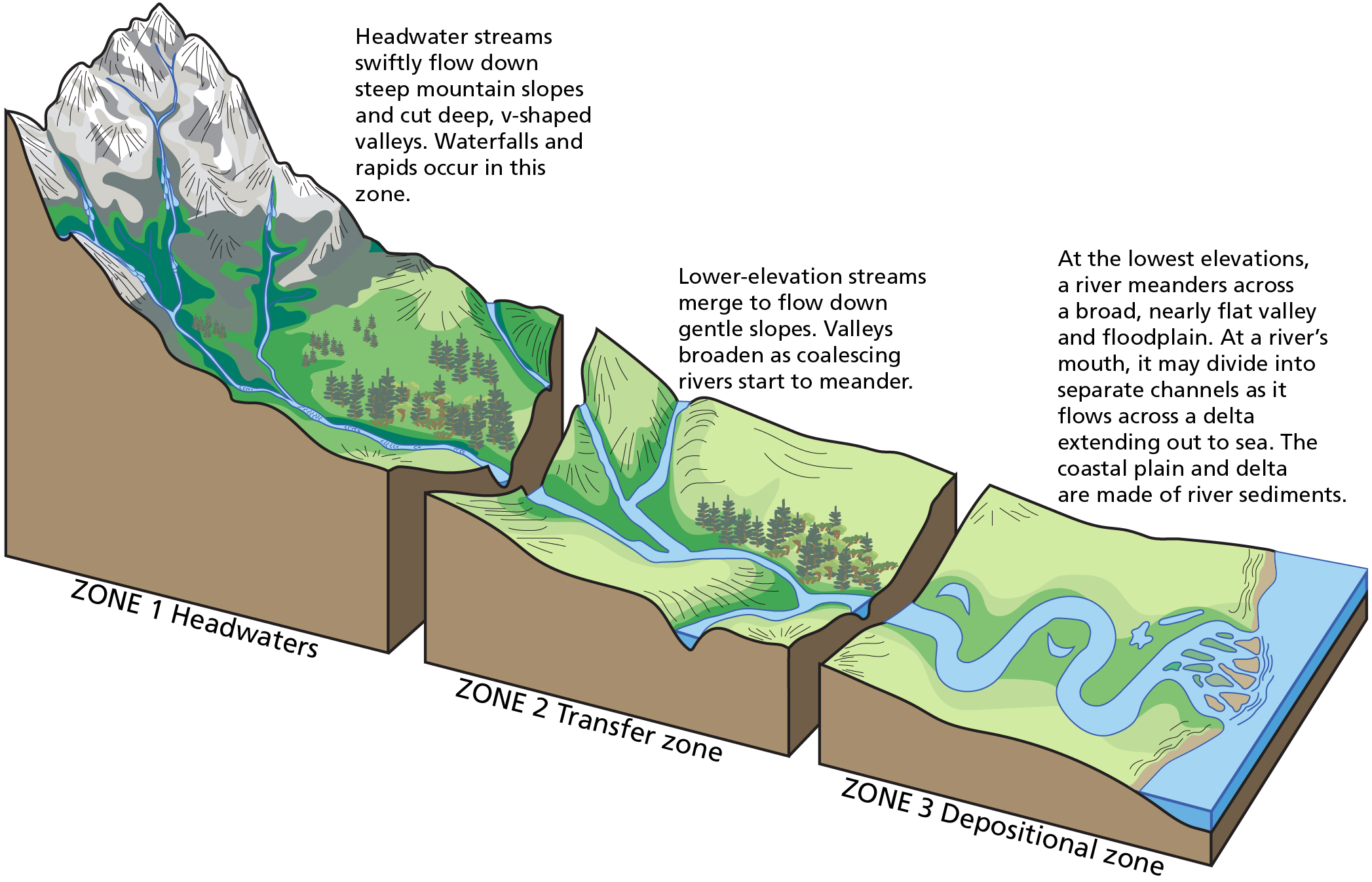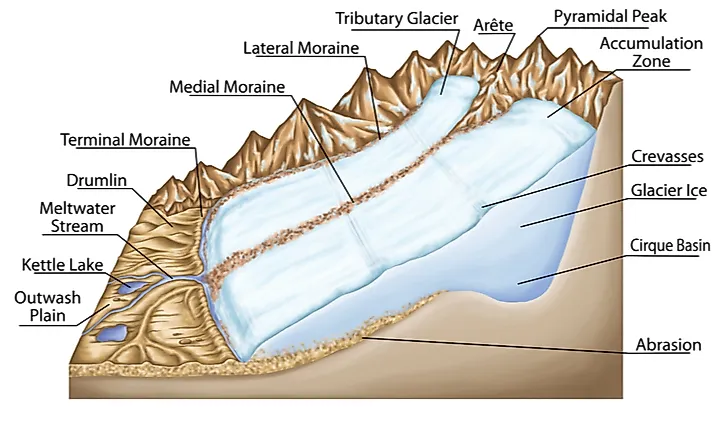There are three types of submarine mass movements which are submarine slumps semicoherent blocks slip downslope on weak horizons. Drainage Basins classic patterns Lakes and Dams Mountain Streams Straight Rivers Braided Rivers Meandering Rivers Anabranching Rivers Gulleys River Terraces Waterfalls Flood plains Alluvial Fans 1 Photo.

River Systems And Fluvial Landforms Geology U S National Park Service
The Grand Canyon has been eroded over millions of years by the Colorado River and its tributaries where it carries the sediments down the river.

. It is formed due to the rivers. Fault contact is usually marked my single line across a layer of rocks. Erosion transportation and deposition the Hjulström Curve.
Glacial till Outwash deposits and plains Moraines Terminal lateral and ground moraineseskerdrumlins Nunatak roche moutonne. Terminal Moraine is deposited by the glacier at the snout as it retreats. On a map depositional contact is represented by parallel layers lines that stack on top of each other.
These are erosion transportation and deposition. Hydrosphere - Water in all its forms Cryosphere - Subset of Hydrosphere including water frozen as snow and ice. They have 3 main components the nearshore where the land begins to affect the sea the foreshore surf zone and the backshore usually above the high tide mark.
On the basis of shape. The energy in a river causes erosion. The Grand Canyon and the Whitsundays are two perfect examples of weathering erosion and a phenomena called deposition.
Arcuate delta Arcuate delta is triangular in shape. Rocks on land in Egypt contained marine fossils assumed that the Nile Delta took thousands of years to form. The backshore typically features the material deposited by storm waves.
Beaches The beach is the area between the lowest spring tide level and the point reached by the storm waves in the highest tides. Intrusive contact on a map looks like a rock seeped into another layer of rock and it creates little circles or other shapes. Are formed by a combination of erosion transportation.
These plains are formed by the deposition of sediments brought down by rivers. The three types of rock contact is depositional contact intrusive contact and fault contact. Depositional plains It is of five types.
When wave velocities slow down or when ocean currents slow down because of frictional forces like the sea bed vegetation and other counter currents deposition occurs. There are three types of Moraines. There are three main types of processes that occur in a river.
A depositional coast is one for which deposition of sediment takes place at a rate that is faster than erosion. Formation and Various Types of Depositional Landforms The coastal landforms resulting out of deposition include Spits Saltmarsh Beaches Other coastal landforms are Delta landforms Estuary landforms Lakeshore landforms Rocky coast landforms Sandy coast landforms Tropical coast landforms Headlands and Bays. They are formed through the geomorphological process.
Lithosphere - Earths inorganic portion of land both on land and on seafloors. Truncated delta On the basis of growth. ATug Hill Plateau BAdirondack Mountains CSt.
Cirque and cirque lake Horns and Serrated ridges Arêtes Glacial valleys troughs Hanging valley. Examples are- Mississippi delta Lomb-ardi plains Italy formed by Po river Yangtze plain China Indus plain Ganga USA plain Sacramento Russia Samarkand South America Chile plain Amazon plain Salween and Mekong plains. Types of glacier.
Landforms of Coastal Deposition Coastal deposition is when the sea drops or deposits material. Describe the various features of a karst landscape and explain how such landscapes evolve. Lawrence Lowlands DChamplain Lowlands.
On the basis of shape. Atmosphere - Gaseous envelope of air that surrounds Earth. Wave zones and beach morphology The gradient of the beach tends to change during the year.
The plains formed by the filling up of sediments carried by agents of Erosion like wind rivers glaciers and underground water into depressions are called Depositional plains. The main depositional features of the glacial landscapes are. These are made up mainly from sediments deposited by waves.
Is material carried in the middle of the glacier. Biosphere - All the parts of the Earth where living organisms exist. These are the glacially formed accumulation of unconsolidated glacial debris.
All three depend on the amount of energy there is in a river. SCGS Fluvial Landforms Processes Rivers are one of the most dominant agents of landscape change. 3The Catskills landscape region is classified as a plateau because it has Amountain Bplateau Clowland Dplain 4New York States Catskills are classified as which type of landscape region.
Dry land can be submerged land can be raised from beneath the ocean described erosion by rivers and deposition in deltas. They can be both currently as well as the formerly glaciated regions of earth. Look at the location map of coastal landscapes in.
Outer edges are like an arc of a circle or a bow. Is the material that has fallen onto the side of a glacier and carried along by it. The major depositional coastal landforms are beaches spits and bars.
This can include sand sediment and shingle resulting in landforms of coastal deposition.

5 5 Depositional Environments And Sedimentary Basins A Practical Guide To Introductory Geology

A List Of Glacial Depositional Features Or Landforms Worldatlas

Glacial Erosion And Deposition Earth Science

Erosion And Deposition By Glaciers Ck 12 Foundation

Types Of Depositional Landforms

Weathering Erosion Deposition 8th Grade Science


0 comments
Post a Comment